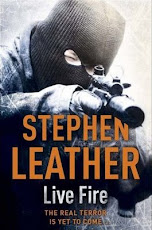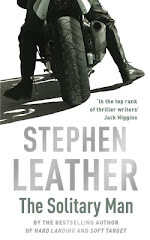I’m still working hard on Dark Justice, the new Dan Shepherd book. Just hit 120,000 words. It’s funny, I was trying so hard to bring it in at 110,000 words but it just won’t have it and all the signs are that it will end up as long as the last three – ie 135,000 words.
I got another email about mistakes in Live Fire – mainly the fact that I had a revolver with a silencer and silencers don’t work with revolvers. I’d already arranged for that to be changed in the mass-market paperback edition, which will be out in September. The reader also pointed out that blanks won’t chamber a second round, though I’m still not sure that’s true. I fired a replica Glock last year loaded with blanks and I’m pretty sure that it ejected the round and chambered a second. I didn’t fire it a second time because I had fired it in my flat in Maida Vale and it was very, very loud and there was a strong smell of cordite that lingered for days! But he did spot a couple of other things!
Anyway, here’s the first email from the reader:
This is another really good yarn. Keep up the good work. I have a couple of comments which just might improve future efforts.
1) On page 15 a safety is flicked off a large revolver. There is NO SAFETY ON A REVOLVER - either large or small.
2)On page 262 et seq the subject of blank ammunition comes up. Nobody even slightly familiar with blank ammunition would mistake a live round for a blank round. Even were that true, a magazine loaded with blanks would not re-cycle a semi auto pistol unless the pistol was fitted with a very obvious blank adaption device. If the pistol was cocked and a blank was up the spout it wold go "bang" but with no back pressure the breachblock would not be forced backward to allow another round to be chambered. So - only one blank cartridge would be fired. The 9mm blank was used extensively in Commonwealth armies when training with both the sten SMG and the Browning auto (semi) pistol. It would work well in the Beretta 92 and because that is a double action pistol it wold not even have to be cocked before firing provided a round was loaded Just pull the trigger.
By the way...I think fracture and break --as per bones--mean the same.
I think the term wheel base is used to measure the length of a vehicles' wheels " fore and aft"
Finally, good luck with the glass cutter on page 470...perhaps however we can excuse this on grounds of artistic license.
I look forward to your next book. I always enjoy them. Regards. Lorne Newson
Here’s the reply I sent!
Cheers, Lorne!
Yeah, I'd spotted the revolver with a safety and have changed that for the paperback edition.
Re the blanks. I have a blank-firing Glock replica....it's been a long time since I fired it (very noisy and not a good idea in North London!) but the last time I did I'm pretty sure it ejected the empty casing. That means the receiver must have gone back, which I assume means that a new round was chambered. Or is my memory playing tricks with me?
I'm flat out on the new book, hoping to keep mistakes to a minimum!
Best wishes,
Stephen
PS What was wrong with fracture, wheel base and the glass cutter? I'm confused!
And then Lorne got back to me....
It is my understanding from a career in police work and therefore more than a few times in emergency wards that a fracture and a break are the same. That is not the impression I got from your comment about the injured nose. I also learned that I have been known to be wrong (on very rare occasions of course) so check with a doctor.
My interpretation of your description of setting the ramps up so the vehicle (was it a SUV?) could cross was you intended the term "wheel base" to be the measurement of the distance of the wheels from side to side.(Thereby telling you how far apart the ramps should be placed) Expressed another way, the measurement between the two (for example) rear wheels. I think " wheel base" is the measurement of the wheels from front to back, for example the distance from the right front axle to the right rear axle
Your books very much appeal to me, perhaps because of my military /police background. After retirement from the RCMP I was the Chief Provincial Firearms Officer for British Columbia, Canada and adminstered all laws regarding guns. I was also an avid collector of military cap badges, so you can see why I might relate to Dan.
Regarding the Glock...I can't say, but I do know the 9mm blank would not cycle the action on either a Browning service pistol or the Sten SMG.(nor a Schmeisser SMG) Nor would the 30 NATO blank cycle the F.N. Rifle. The same applies to the .303 and (and how I loved that weapon except for carryng - 21 lbs -the darned thing) the Bren LMG. During army field training - so the machine gun would fire fully automatically- the military used to attach a (yellow as I recall) adapter onto the muzzle to ALMOST block the expulsion of the gasses thereby allowing blowback in the case of the sten and to allow the gases to go through the gas block in the case of the Bren. In my CPFO days I loaned a schmeisser to an army armourer for a military demonstration and he fashioned a somewhat ingenious device whereby he took a piece of bent steel, - somewhat like a capital letter "L" and used a couple of hose clamps to fix the thing to the barrell with the shorter horizontal part of the "L" across the muzzle. He had bored a hole in that and put a threaded bolt thru the steel with the thing actually protruding inside the barrel, thereby restricting the gas expulsion and acheving his "blowback"
Glass cutter. Most modern window in high buildings are of the type that if they are knicked or broken they do not fall down in shards of broken glass but in fact the whole window is reduced instantly to small pieces about the side (or smaller) of a pea. You will see this type of glass in the side and rear windows of automobiles. Also in windshields except there they put a thin layer of rubber between two sheets of glass for safety reasons, hence the term "safety glass". In double glazed glass, sometimes ordinary window glass is used but from what I've seen a glass cutter is only effective in dealing with a flat piece of glass and for the length of the sheet. A straight line, or even a wavy line scored in the glass with result in a break along the score mark when the glass is "bent" I don't think it would work on a double glazed window. Might just as well break the damned thing and get on with the shooting.
So here I am, a Mr Smart guy with 4 criticisms. Even if I'm right 3 out of 4 it might be constructive. Best Wishes on the next book. Lorne Newson
He made good points, and I certainly never realised that a break and a fracture where the same thing! Anyway, here’s my reply to Lorne!
Cheers, Lorne,
Well, the great thing about being a writer is that you learn something every day. Who knew that a break and a fracture were the same thing? I always assumed that a fracture was a slight break, like a crack, and that a break meant that it was literally broken. Wrong!! Now I know better!! Thanks for pointing that out and I'll try to get it changed.
And wheel base. Who knew? Well, you obviously did! I always assumed that wheelbase referred to the width, I had no idea it was the distance between the axles. Makes a nonsense of my copy, obviously, so I'll try to get it changed!
I'll check my Glock when I get back to the UK but I'm pretty sure that it does put a second in the chamber after it has ejected the first. Maybe because it's lightweight?
The glass cutter? I don't know. I know that a guy cut a circular hole in my bathroom window to fit an extractor fan, but having said that I didn't watch him do it. I think you're right and in future I'll stick to the old faithful piece of sticky-backed plastic and an elbow!
Thanks again for putting me right. I've just hit 120,000 words on the new Dan Shepherd book, and I've got my fingers crossed that there are fewer mistakes this time!
Best wishes,
Stephen
Subscribe to:
Post Comments (Atom)






































No comments:
Post a Comment